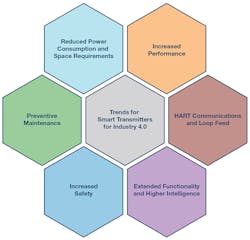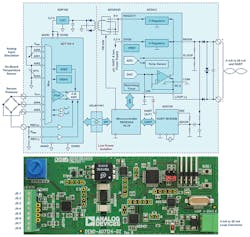Humankind is constantly being pushed to greater heights through developments in technology and industry. These developments are marked by great leaps, or milestones, in technological history known as industrial revolutions. Now we’ve come to a new stage: Industry 4.0.
The first, second, and third industrial revolutions heralded in the use of steam and water power for production, mass production using electricity, and computerization, respectively. In the fourth revolution, the focus has switched to the digital automation of factories. Digital automation is used in all areas of a company to increase efficiency through automatic control. With this type of control, preventive maintenance is possible, and production and availability can be increased. Through completely networked operations, supply routes can be better planned, storage costs eliminated, and improved utilization guaranteed.
In these times of continuously rising demand, machine downtime is costly. A networked factory facilitates planning and, hence, helps prevent interruptions in production.
Industry 4.0’s focus isn’t solely on new developments. The continued use and expansion of existing infrastructures to achieve fast amortization for the digital factory is another element that takes the cost factor into account. For smart-factory operators, acquisition costs (which should be low) and the need for major structural alterations (which should be nonexistent) are important criteria that must be assessed in a cost-benefit analysis.
Smart Transmitters
A key aspect in realizing a smart factory is the use of field instruments possessing intelligence—so-called smart transmitters. They support factory monitoring and diagnostics as well as networking with additional new field instruments. These transmitters can be distributed over the entire plant, different sensors can be connected, and previously unconnected parts can be monitored. The field instruments form the universal, intelligent basic unit of Industry 4.0. These units will be considered in more detail using the example of an instrument that can be employed with various sensors, such as resistance thermometers, thermocouples, and pressure sensors.
Developed from the field instruments commonly in use today, smart transmitters are intelligent field instruments that are either purely loop-fed or supplied with auxiliary energy. A smart transmitter, besides containing other components, utilizes a microprocessor containing the software needed to make a transmitter smart. However, the intelligence of a field instrument doesn’t have to be stored solely in the microcontroller software. Diagnostics and other safety features can also be integrated into other semiconductor modules (for example, analog-to-digital converters (ADCs)) so that the microcontroller is able to contain additional processing software.
Smart transmitters usually use the standard 4- to 20-mA current loop, which restricts the maximum power consumption of a transmitter. The consumption of the respective components must therefore be strongly limited. If a so-called 3.2-mA low alarm current is used, this limit is 3.2 mA. Trends in smart transmitters include low power consumption, low space requirements, greater functionality, better performance, safety considerations, and preventive maintenance (Fig. 1).
1. Among the key trends for smart transmitters in Industry 4.0 are low power consumption, low space requirements, and preventive maintenance.
A typical smart-transmitter signal chain is shown in Figure 2. The instrument contains a sensor and an ADC, which is often made up of an analog front end and an analog preprocessing unit. From the ADC, the digital signal is fed through an insulation barrier into a microprocessor and then into an interface. A two-wire solution via the 4- to 20-mA interface is usually used nowadays in plant automation, which requires a digital-to-analog converter (DAC).
2. Shown is a block diagram of a smart-transmitter signal chain.
A highway addressable remote transducer (HART) protocol enables bidirectional use of the interface. If the control room is also HART-compatible, more complex processes can be transmitted via the HART protocol and, in turn, more benefit is drawn from the field instruments.
Reference Circuit Example
In the following, the role of each component is described in more detail, along with a circuit that’s designed to be especially effective and space-saving. The circuit was built up with Analog Devices modules that help satisfy Industry 4.0 requirements and exhibit high precision and low power consumption. Figure 3 shows a schematic circuit diagram (top) and a pictorial circuit diagram (bottom).
3. This reference circuit, shown schematically (top) and pictorially (bottom), leverages several Analog Devices modules.
The sensor is connected to an analog-to-digital converter; in this case, an AD7124 24-bit Σ-Δ ADC. This ADC integrates a space-saving analog front end that doesn’t require an external instrumentation amplifier nor an operational amplifier. The AD7124 can be designed flexibly with four or eight differential inputs for use with various sensors. In addition, the ADC has a programmable power source, which is essential, for example, for passive temperature sensors, as well as three different power modes for greater flexibility.
The precision and the output data rate are determined through selection of the power mode. As a result, it’s also possible to operate the field instrument below a power limit of 3.2 mA to enable connection of more powerful microprocessors or additional sensors for parallel measurements.
Diagnostics capabilities of the AD7124 include:
- Read/write with no exceptions in valid registers
- Only valid data are read to the register
- Validation of clean decoupling of voltage regulator (LDO)
- Validation of the performance of ADC modulators and filter to specifications
- Validation of overvoltage or undervoltage
Not only do these precautions make it easier to comply with safety standards, but the information can also be passed on via the HART protocol to plan maintenance work on the field instruments far in advance. Due to the higher availability and lower maintenance requirements that result from it, Industry 4.0 offers a huge efficiency boost.
The insulation of the field instrument is another crucial aspect. Inadequate insulation can lead to ground loops and overvoltages, which could damage not only the instrument, but also a connected programmable logic controller (PLC) when transmitted via the two-wire connection. Good insulation often runs up against the current limit for loop-fed field instruments. However, in this example, the ADuM1441 digital insulator is used. For low data rates, much less power was required than previous solutions, thus enabling adequate insulation within the given consumption limits.
Another element of the field instrument besides the AD7124 and the ADuM1441 unit is the microcontroller (MCU). Typically, Arm-based MCUs like the ADuCM3027/ADuCM3029 are used. Their active consumption is less than 38 µA/MHz, making them ideal for smart transmitters. The Arm MCUs are widespread in industry and thus also suitable for safety-relevant applications. The ADuCM3027/ADuCM3029 also incorporate AES-128/AES-256 encryption to enable additional security functions. Smart software can be programmed on these MCUs, making it possible to perform diagnostics—for example, calibration of the AD7124 ensures that the field instrument delivers accurate measurements.
Take it to HART
The HART protocol allows for smart design of field instruments without major infrastructure requirements. It can be used over a 4- to 20-mA current loop, although this requires a HART slave and a HART master. HART enables the user to establish a digital connection between the field instrument and the PLC. This creates a smart connection between the control room and the field instrument.
Implementing HART requires a HART modem with a connection to a HART-compatible DAC. The devices must be highly integrated and have low power consumption. These two factors—low space requirements and low power consumption—are the basic prerequisites for Industry 4.0.
HART enables digital communications on the existing current loop, but a HART modem is required to modulate this signal to a clean current signal. The AD5700 ultra-low-power HART modem was developed for this purpose.
The last pillar of a modern field instrument is the digital-to-analog converter. Here, too, in keeping with Industry 4.0, low power consumption and high integration must be kept in mind. The DAC is a key component of the entire circuit—instead of taking up space on the PCB, as much as possible is integrated into the DAC. An example is a linear regulator that also supplies the entire field instrument. Furthermore, it enables communications with the PLC and thus assumes the control and monitoring of the unit. One DAC that harmonizes well with the HART modem is the AD5421.
The signal chain described here illustrates a possible design for an Industry 4.0-compatible loop-fed field instrument for pressure or temperature measurement. This smart transmitter can be used for smart monitoring, control, and feedback, and was designed particularly for low space requirements and low power consumption.




